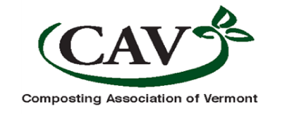Community composting keeps the process and product as local as possible, while engaging the community through participation and education.
Franklin Street Homeowner’s Association, Barre, VT. Image credit Cassandra Hemenway, CVSWMD
Organics are one of the few materials that can be entirely managed locally. When we change how we think about these materials – from waste to resource – they become a valuable asset that can serve the community and support local food systems.
Ranging widely in size (from 10 to 20,000 square feet), community composting is often volunteer run, or managed as part of an on-farm system or by non-profits or small businesses. Focused on managing organics locally and producing compost for local use, in both urban and rural settings, the emphasis is on promoting community partnerships and connections.
Community composting provides an essential role in the evolution of food scrap diversion from the waste stream, normalizing composting at all scales – from backyard to commercial.
Benefits of Community Composting
Increased local economic vitality
Community engagement
Improved soil health
Reduced storm water runoff & pollution mitigation
Waste reduction
Climate protection
Applied learning
Adapted from Community Composting Done Right, ILSR, 2019.
Background
Building on a pilot project, Community Composting at Community Gardens led by CAV, CAV worked with a team of organics experts assembled by the Northeast Recycling Council (NERC) on a project, Implementing Rural Community Composting in Connecticut, Maine, Massachusetts, New Hampshire, New York, and Vermont to develop training materials and to provide training and technical assistance to eight community composting sites.
The training materials were subsequently organized into five training modules, found below.
Experts included Libby Weiland, Statewide Network Coordinator, Vermont Community Gardens Network; Dawn Pettinelli, Assistant Extension Educator, Department of Plant Science & Landscape Architecture, University of Connecticut Soil Nutrient Analysis Lab; Jean Bonhotal, Director, Cornell Waste Management Institute (CWMI), Department of Crop and Soil Sciences; and, Beret Halverson, State Coordinator, UVM Extension Master Gardener & Master Composter Program. Key NERC staff involved in the project were Athena Lee Bradley, who initiated the project, and Cindy Sterling.
The project was funded through the US Department of Agriculture, Rural Utility Services, Solid Waste Management Grant Program. BioBags America, Inc. donated kitchen caddies and compostable food scrap collection “BioBags” to project sites.
Community Composting Training
Click on the headings to learn more
+1 Introduction to Community Composting
This module explains more about community composting, the benefits it provides to participants and their wider communities, and includes a summary overview, a tip sheet on community composting regulations, as well as a recorded webinar (Getting Started).
+2 System Support: The People
While it's tempting to jump right into choosing a system and learning the science, community composting is a people-based effort! Module 2 encourages you to take some time to think through your goals (the vision and mission for your site), your compost team and stakeholders, and how you'll communicate with your team members as well as the wider community. Included in this module are a number of tip sheets, worksheets, references, and some ideas for developing a budget and fundraising.
+3 Community Compost Operation Logistics
Module 3 is all about setting up your site and managing the science of composting. Site layout and logistics are key, whether starting a new site or rethinking an existing one. This module provides an overview of the different steps of managing a compost system - from collecting feedstocks, to screening and distributing the finished compost. You'll also find information about different composting systems and exercises to help you visualize how to set up your site. We also get into different recipes and the process of composting, so that you can maximize the results realized from your efforts!
+4 Best Management Practices (BMPs)
It’s very normal for community composting sites to go through iterations of site design, system choice, operations management and recipe! Module 4 is all about managing your community composting site in a way that's safe and enjoyable for site members as well as your surrounding community. Resources include videos and tip sheets on troubleshooting and keeping the system going after initial setup.
Day in the Dirt Volunteers. Image credit: Vermont community garden network
Compost Log at Charlotte Central School. Image credit: Vermont COmmunity Garden Network






